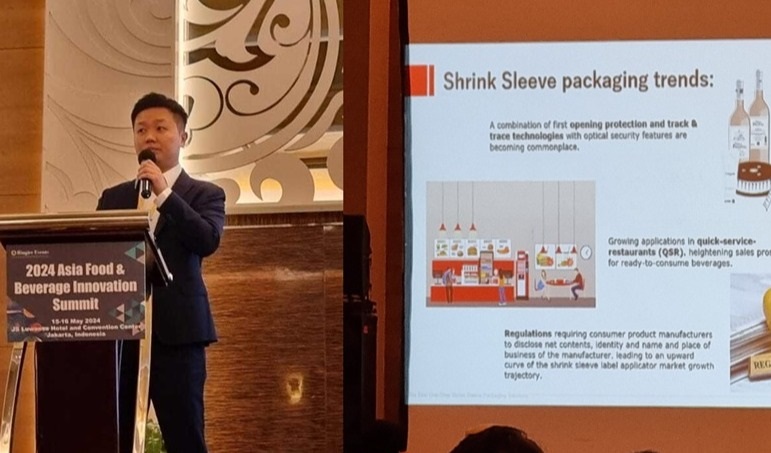Dase-Sing CEO's presentation highlights innovation as key driving growth at F&B summit in Jakarta
Date Published:7/28/2024 04:07:31 下午
The Asia Food and Beverage Innovation Summit hosted by Ringier Events gathered some two hundred participants from the local F&B manufacturing and packaging sectors at the JS Luwansa Hotel & Convention Centre in Jakarta from May 15 to 16, 2024. Industry professionals, academics, and private sector representatives came together to share and discuss crucial topics in food processing and nutrition, packaging technologies, sustainability, food security, and Halal certification.
Key personalities in the industry joined the conference as speakers including Rachmat Hidayat, Vice Chairman, Public Policy and Interagency Relationship Association of Indonesian Food and Beverage Manufacturers; Henky Wibawa, Executive Director of the Indonesia Packaging Federation; Dr Joseph Ross Jocson, president of the Asian Packaging Federation; Triyono Prijosoesilo, Director of Public Affairs, Communications and Sustainability, from PT Coca-Cola Indonesia.
Taiwan company, Dase-Sing Group was among the business partners of this event. In the area of packaging, CEO Mr .Tony Huang, presented on the latest shrink sleeve packaging trends and solutions.

Having been in the packaging business since 1985, Dase-Sing is no stranger to changing market trends and packaging developments. The company continues to adapt to industry requirements and to the needs of its customers across Asia and other regions. Proof is in company’s latest designs and machine upgrades for shrink sleeves, 16-color automatic rotogravure printing labels and automatic sleeves. As a vertically integrated packaging company, it offers film materials to shrink sleeve machines, and handles printing.
During his presentation, Mr. Huang stressed the importance of innovating products that are aligned with the trends in carbon footprint reduction, reusable packaging, and fiber-based packaging solutions. He talked about the impact of digitalization, AI, traceability, and data analytics in relation to efficiency enhancement, and the consumer experience.
But why use shrink sleeves? Are they sustainable?
The shrink sleeve & stretch sleeve labels market which was projected to reach USD 15.90 billion in 2022, is expected to grow at a CAGR of 5.5%- 6.0% from 2022 to 2032. According to Mr. Huang, with the e-commerce and quick-service restaurant sectors driving this growth, F&B companies should be motivated to meet this demand for sustainable packaging.
Shrink sleeves offer many benefits to product packaging: attractive appearance, product protection, and ease of recycling. Mr. Huang specifically highlighted the cost-effective benefit of using shrink sleeves. He said a company with different products can use the same bottle or container for these, and set these products apart by simply using different sleeves. It is an ideal scheme to cut time to market as well as storage cost, he said.
He explained that full body shrink sleeves that wrap around bottles also help protect contents from UV light. Another safety advantage of sleeves is that printing on the containers do not easily scratch off, thereby preventing possible physical tampering.
Innovations in shrink sleeves reduce carbon footprint
Advances in shrink sleeves now help companies further reduce their carbon footprint, according to Mr. Huang. For example, low-density shrink labels are ideal to use compared to traditional shrink sleeves. These labels can separate from PET containers and float on water during the recycling process. As such they do not contaminate the PET during at the recycling stage.
Another trend is the use of de-seaming adhesive to replace traditional solvent seams. The adhesive enables faster removal of labels in the wet recycling process.
Washable inks with higher melting point are also preferred as they eliminate clumping in the drying systems. The washable solvent ink is removed from the film during the washing stage.
Perforation on shrink sleeves is a popular choice for easy recycling. By pulling on the strip, at the seam, and the sleeve tears right away from the bottle/container. This allows consumers to toss the sleeve in the trash and place the bottle in their recycle bin.
Another sustainable trend is the use of shrink sleeve material containing post-consumer recycled content (PCR). The film clarity, print quality and shrinkage properties are the same as those found in standard polyethylene terephthalate (PET) shrink sleeve film material.
Meanwhile downgauging film is also on demand. By reducing the thickness of the film, companies can reduce cost and the carbon footprint at the same time.
Furthermore, Dase-Sing enables manufacturers to meet high SKU objectives with the same production time with its high-speed modular sleeving systems. Mr. Huang mentioned that in labelling speed options, many companies prefer above 600 BPM (up to 720 BPM for 3-head upgradable machine) as their labelling speed and container diameters within 50 to 100 mm. They also prefer to reduce film thickness to save on material and cost.
Mr. Huang’s presentation concluded with a forward-looking perspective on the need for collaboration and continuous innovation in packaging to stay competitive.
